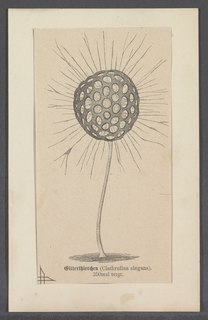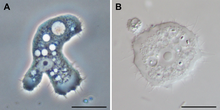
The Cercozoa are a group of single-celled eukaryotes. They lack shared morphological characteristics at the microscopic level, being defined by molecular phylogenies of rRNA and actin or polyubiquitin. They are the natural predators of many species of microbacteria and Archea.

Amoebozoa is a major taxonomic group containing about 2,400 described species of amoeboid protists, often possessing blunt, fingerlike, lobose pseudopods and tubular mitochondrial cristae. In most classification schemes, Amoebozoa is ranked as a phylum within either the kingdom Protista or the kingdom Protozoa. In the classification favored by the International Society of Protistologists, it is retained as an unranked "supergroup" within Eukaryota. Molecular genetic analysis supports Amoebozoa as a monophyletic clade. Most phylogenetic trees identify it as the sister group to Opisthokonta, another major clade which contains both fungi and animals as well as some 300 species of unicellular protists. Amoebozoa and Opisthokonta are sometimes grouped together in a high-level taxon, variously named Unikonta, Amorphea or Opimoda.

Lobosa is a taxonomic group of amoebae in the phylum Amoebozoa. Most lobosans possess broad, bluntly rounded pseudopods, although one genus in the group, the recently discovered Sapocribrum, has slender and threadlike (filose) pseudopodia. In current classification schemes, Lobosa is a subphylum, composed mainly of amoebae that have lobose pseudopods but lack cilia or flagella.

Streptophyta, informally the streptophytes, is a clade of plants. The composition of the clade varies considerably between authors, but the definition employed here includes land plants and all green algae except the Chlorophyta and possibly the more basal Mesostigmatophyceae, Chlorokybophyceae, and Spirotaenia.

Amorphea are members of a taxonomic supergroup that includes the basal Amoebozoa and Obazoa. That latter contains the Opisthokonta, which includes the Fungi, Animals and the Choanomonada, or Choanoflagellates. The taxonomic affinities of the members of this clade were originally described and proposed by Thomas Cavalier-Smith in 2002.

The tectofilosids are a group of filose amoebae with shells. These are composed of organic materials and sometimes collected debris, in contrast to the euglyphids, which produce shells from siliceous scales. The shell usually has a single opening, but in Amphitrema and a few other genera it has two on opposite ends. The cell itself occupies most of the shell. They are most often found on marsh plants such as Sphagnum.

Chaos is a genus of single-celled amoeboid organisms in the family Amoebidae. The largest and best-known species, the so-called "giant amoeba" Chaos carolinensis, can reach lengths of 5 mm, although most specimens fall between 1 and 3 mm.

The Amoebidae are a family of Amoebozoa, including naked amoebae that produce multiple pseudopodia of indeterminate length. These are roughly cylindrical with granular endoplasm and no subpseudopodia, as found in other members of the class Tubulinea. During locomotion one pseudopod typically becomes dominant and the others are retracted as the body flows into it. In some cases the cell moves by "walking", with relatively permanent pseudopodia serving as limbs.
The Vannellidae are a family of Amoebozoa, which are found in soil, fresh- and salt water. The most common genus is Vannella.

The Tubulinea are a major grouping of Amoebozoa, including most of the more familiar amoebae genera like Amoeba, Arcella, Difflugia and Hartmannella.

Monadofilosa is a grouping of Cercozoa. These organisms are single-celled amoeboid protists.

Arcellinid testate amoebae or Arcellinida, Arcellacean or lobose testate amoebae are single-celled protists partially enclosed in a simple test (shell).
Dactylopodida is an Amoebozoa grouping.
Hartmannella is a genus of Amoebozoa.

Testate amoebae are a polyphyletic group of unicellular amoeboid protists, which differ from naked amoebae in the presence of a test that partially encloses the cell, with an aperture from which the pseudopodia emerge, that provides the amoeba with shelter from predators and environmental conditions.

Ancyromonadida or Planomonadida is a small group of biflagellated protists found in the soil and in aquatic habitats, where they feed on bacteria. Includes freshwater or marine organisms, benthic, dorsoventrally compressed and with two unequal flagellae, each emerging from a separate pocket. The apical anterior flagellum can be very thin or end in the cell membrane, while the posterior flagellum is long and is inserted ventrally or laterally. The cell membrane is supported by a thin single layer teak and the mitochondrial crests are discoidal / flat.

The Flabellinia are a subclass of Amoebozoa. During locomotion the cells are flattened and have a clear layer called hyaloplasm along the front margin. Some form slender subpseudopodia projecting outward from the hyaloplasm, but the cell mass does not flow into these as in true pseudopodia, and advances without a definite central axis as in the Tubulinea. They also lack distinctive features like shells and flagella, and are united mainly by evidence from molecular trees.

Cryptista is a clade of algae-like eukaryotes. It is sometimes placed along with Haptista in the group Hacrobia, within the kingdom Chromista. However, in 2016, a broad phylogenomic study found that cryptists fall within the group Archaeplastida, while haptophytes are closely related to the SAR supergroup.

Granofilosea is a class of cercozoans in the subphylum Filosa.
Anaeramoeba is a genus of anaerobic protists on uncertain phylogenetic position, first described in 2016.














